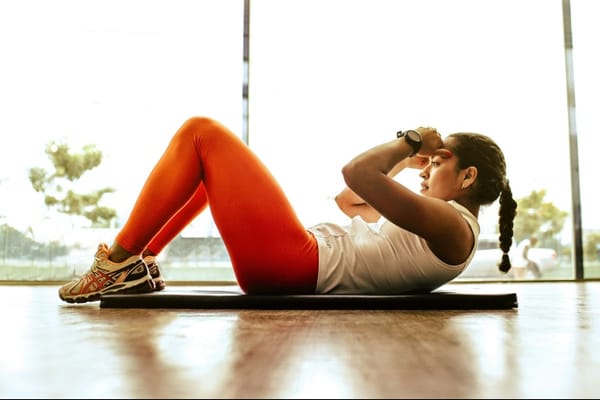In today's fast-paced world, finding time for a comprehensive workout can be challenging. Many people believe that building strength requires hours at the gym and access to a wide array of equipment. However, this couldn't be further from the truth. With just a set of dumbbells and 30 minutes of your time, you can engage in a full-body strength training routine that targets all major muscle groups. This article will explore five effective dumbbell exercises that can help you build strength and muscle, all from the comfort of your home or any small space.
The Power of Dumbbell Training
Dumbbells are versatile tools that offer numerous benefits for strength training. They allow for unilateral (single-sided) exercises, which can help address muscle imbalances and improve overall stability. Additionally, dumbbell exercises often require more stabilizer muscle engagement compared to machine-based exercises, leading to improved functional strength and coordination.
Benefits of Dumbbell Training:
- Versatility: Dumbbells can be used for a wide range of exercises targeting different muscle groups.
- Space-efficient: Unlike bulky gym equipment, dumbbells take up minimal space and are perfect for home workouts.
- Cost-effective: A good set of adjustable dumbbells can replace an entire rack of weights, saving you money in the long run.
- Improved balance and coordination: Working with free weights enhances proprioception and body awareness.
- Muscle activation: Dumbbell exercises often engage more muscle fibers compared to machine-based alternatives.
The 30-Minute Full-Body Dumbbell Workout
This workout consists of five key exercises that target all major muscle groups. Perform each exercise for 45 seconds, followed by a 15-second rest. Complete six rounds of the circuit for a total workout time of 30 minutes.
1. Dumbbell Thrusters
Thrusters are a compound exercise that combines a front squat with an overhead press, engaging multiple muscle groups simultaneously.
Muscles worked: Quadriceps, hamstrings, glutes, shoulders, triceps, and core.
How to perform:
- Stand with feet shoulder-width apart, holding dumbbells at shoulder height.
- Lower into a squat, keeping your chest up and core engaged.
- As you stand back up, press the dumbbells overhead.
- Lower the weights back to shoulder height as you descend into the next squat.
Tips:
- Keep your core tight throughout the movement to protect your lower back.
- Breathe out as you press the weights overhead.
- Choose a weight that allows you to maintain proper form for the entire 45-second set.
2. Renegade Rows
Renegade rows are an excellent exercise for building upper body and core strength while also improving stability.
Muscles worked: Back, biceps, shoulders, chest, and core.
How to perform:
- Start in a high plank position with a dumbbell in each hand.
- Keeping your core tight and hips stable, row one dumbbell up to your ribcage.
- Lower the dumbbell back to the starting position.
- Repeat on the other side, alternating arms with each rep.
Tips:
- Keep your body in a straight line from head to heels throughout the movement.
- Avoid rotating your hips; keep them square to the ground.
- If the full plank position is too challenging, perform the exercise with your knees on the ground.
3. Dumbbell Romanian Deadlifts
Romanian deadlifts are excellent for targeting the posterior chain, particularly the hamstrings and lower back.
Muscles worked: Hamstrings, glutes, lower back, and core.
How to perform:
- Stand with feet hip-width apart, holding dumbbells in front of your thighs.
- Hinge at the hips, pushing your buttocks back while keeping a slight bend in your knees.
- Lower the dumbbells along your legs, keeping them close to your shins.
- Stop when you feel a stretch in your hamstrings, typically when the dumbbells reach mid-shin level.
- Squeeze your glutes and hamstrings to return to the starting position.
Tips:
- Keep your back straight throughout the movement; avoid rounding your spine.
- Focus on hinging at the hips rather than squatting.
- Keep the dumbbells close to your legs throughout the exercise.
4. Dumbbell Push Press
The push press is a dynamic overhead pressing movement that incorporates lower body power to assist in lifting heavier weights.
Muscles worked: Shoulders, triceps, upper chest, and legs.
How to perform:
- Stand with feet shoulder-width apart, holding dumbbells at shoulder height.
- Perform a slight dip by bending your knees and hips.
- Explosively extend your legs and press the dumbbells overhead.
- Lower the weights back to shoulder height under control.
Tips:
- Use the power from your legs to help drive the weights overhead.
- Keep your core engaged to maintain stability throughout the movement.
- Avoid arching your back as you press the weights overhead.
5. Dumbbell Reverse Lunge with Twist
This exercise combines a lower body movement with a core rotation, providing a full-body challenge.
Muscles worked: Quadriceps, hamstrings, glutes, obliques, and core.
How to perform:
- Stand with feet hip-width apart, holding a single dumbbell at chest height.
- Step back into a reverse lunge with your right leg.
- As you lunge, rotate your torso to the left, bringing the dumbbell across your body.
- Return to the starting position and repeat on the other side.
Tips:
- Keep your front knee aligned with your ankle as you lunge.
- Engage your core during the twist to maximize the benefits.
- Maintain an upright posture throughout the movement.
Structuring Your Workout
To get the most out of this 30-minute workout, follow these guidelines:
- Warm-up: Spend 5-10 minutes doing light cardio and dynamic stretches to prepare your body for exercise.
- Circuit training: Perform each exercise for 45 seconds, followed by a 15-second rest. Complete all five exercises in sequence to form one circuit.
- Rest periods: After completing one full circuit, take a 1-minute rest before starting the next round.
- Repetitions: Aim to complete 6 full circuits within the 30-minute timeframe.
- Cool-down: Finish with 5-10 minutes of static stretching to improve flexibility and reduce muscle soreness.
Progressive Overload for Continued Strength Gains
To ensure continued progress and avoid plateaus, it's essential to incorporate progressive overload into your training. This principle involves gradually increasing the demands placed on your body over time. Here are some ways to apply progressive overload to this dumbbell workout:
- Increase weight: As you become stronger, gradually increase the weight of the dumbbells used for each exercise.
- Increase repetitions: Try to perform more repetitions within the 45-second work periods.
- Decrease rest time: Gradually reduce the rest periods between exercises or circuits.
- Increase time under tension: Slow down the eccentric (lowering) phase of each movement to increase muscle engagement.
- Increase workout frequency: Add an extra day of this workout to your weekly routine as your fitness improves.
Nutrition and Recovery for Optimal Results
While this 30-minute dumbbell workout is highly effective for building strength, it's crucial to support your efforts with proper nutrition and recovery strategies:
Nutrition:
- Protein intake: Consume adequate protein (1.6-2.2 grams per kilogram of body weight) to support muscle repair and growth.
- Carbohydrates: Include complex carbohydrates in your diet to fuel your workouts and aid in recovery.
- Healthy fats: Incorporate sources of healthy fats to support hormone production and overall health.
- Hydration: Drink plenty of water throughout the day to maintain proper hydration and support muscle function.
Recovery:
- Sleep: Aim for 7-9 hours of quality sleep per night to allow your body to repair and grow stronger.
- Active recovery: On rest days, engage in light activities like walking or yoga to promote blood flow and reduce muscle soreness.
- Stretching and mobility work: Regularly perform stretching and mobility exercises to maintain flexibility and reduce the risk of injury.
- Stress management: Practice stress-reduction techniques such as meditation or deep breathing to optimize recovery and overall well-being.
Conclusion
Building strength doesn't require hours in the gym or access to extensive equipment. With just a set of dumbbells and 30 minutes of your time, you can engage in a highly effective full-body strength training routine. The five exercises outlined in this article – dumbbell thrusters, renegade rows, Romanian deadlifts, push presses, and reverse lunges with a twist – target all major muscle groups and provide a challenging workout that can be done anywhere.
By consistently performing this workout and applying the principles of progressive overload, you can continue to build strength, improve muscle tone, and enhance your overall fitness. Remember to support your efforts with proper nutrition and recovery strategies to maximize your results.
Whether you're a busy professional, a stay-at-home parent, or simply someone looking for an efficient strength training routine, this 30-minute dumbbell workout offers a practical and effective solution. So grab your dumbbells, set aside half an hour, and start building strength all over your body today!
Sources:













Member discussion